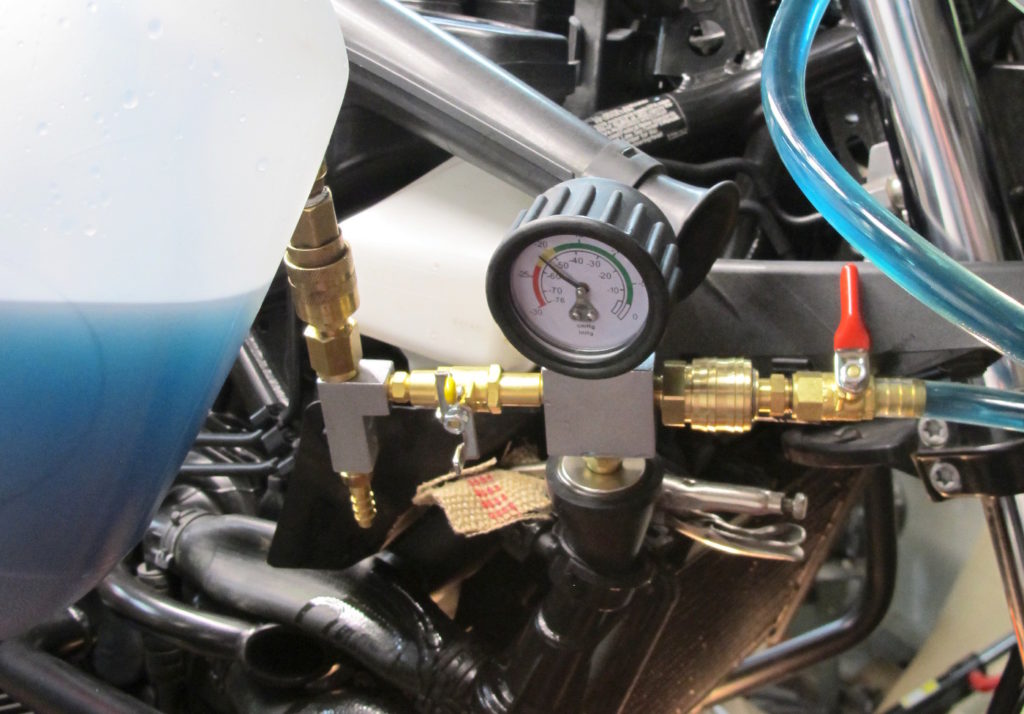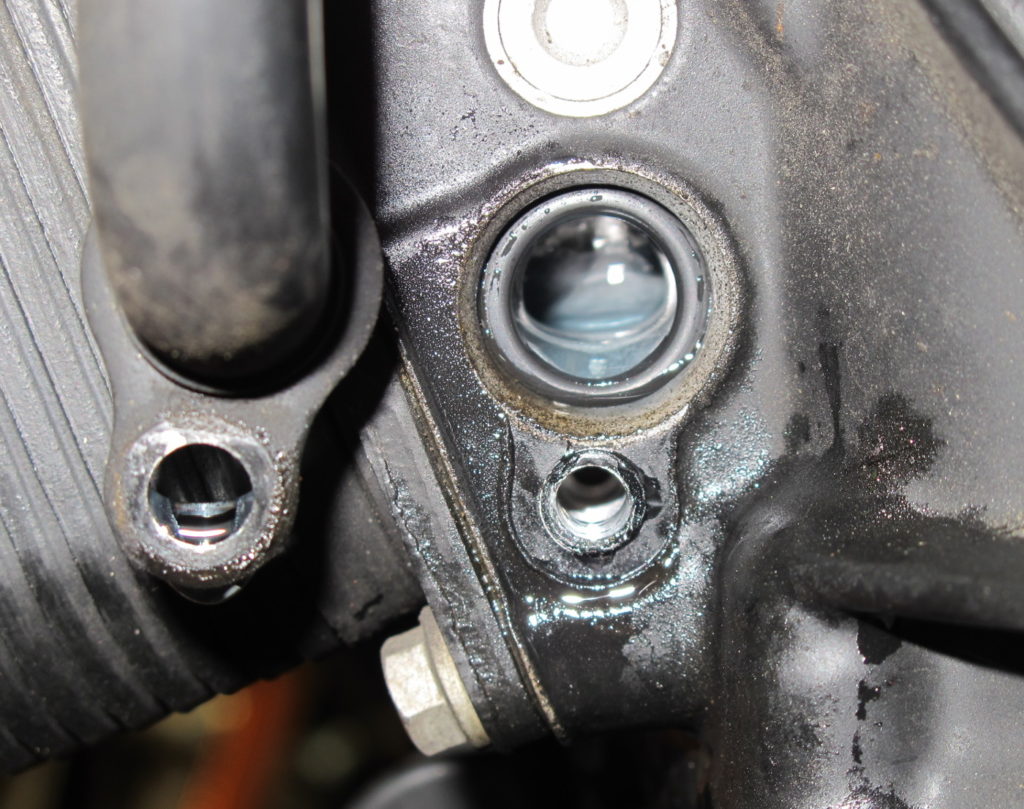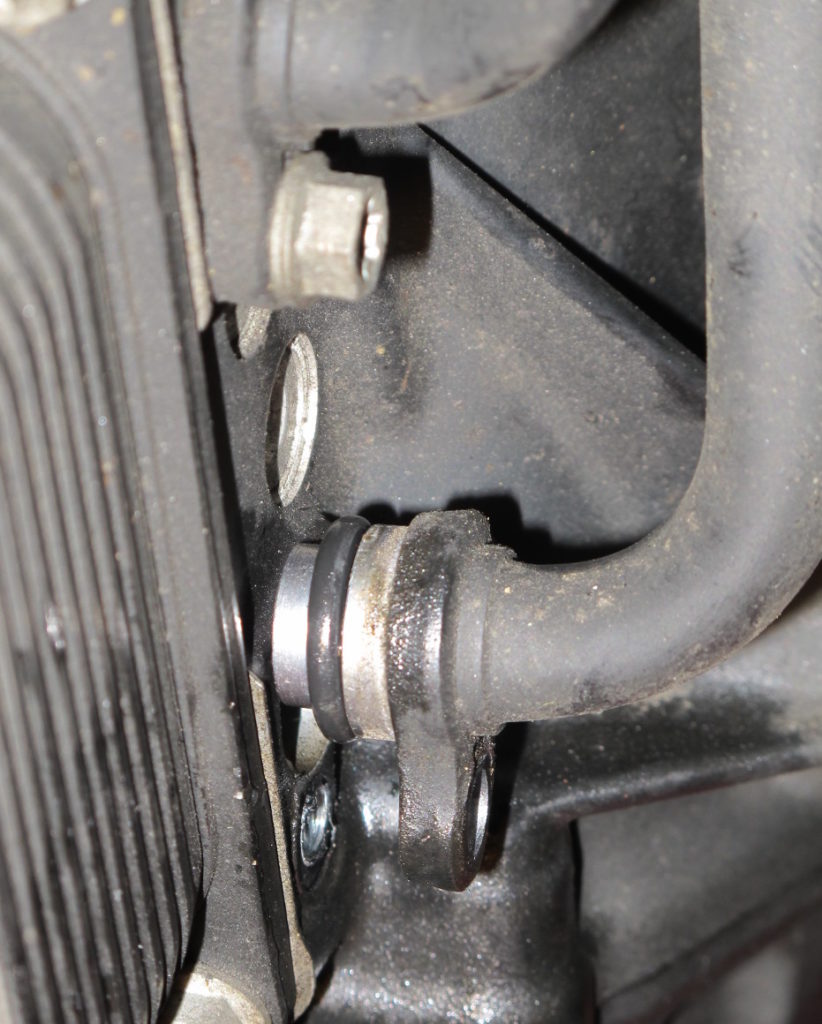Mileage: 10,029
Maintenance Summary:
- Changed Coolant
- BMW Coolant 50/50
- Put Loctite on both oil cooler coolant tube keeper screws.
- Cleaned air filter with compressed air.
The coolant is drained at the lower tube on the heat exchanger located on the bottom, front of the engine. The coolant that came out was very clean.
The single screw holding the tube against the block was a bit too easy to loosen. I reinstalled the screws for both tubes with Loctite.
As you can see in the next picture, the 12 x 17 x 2.5mm o-ring didn’t come out with the tube. This o-ring is supposed to be replaced with each coolant change, but the local BMW dealer didn’t have one. I find that odd given how many of these they should be going through when they service these 800cc twins. The dealer claimed only 10 dealerships in the country had any in stock. Come on BMW, how much can it possibly cost to require your dealers to stock regular maintenance parts that retail for less than $2?
I’ll order some of these for the next coolant change and replace both o-rings then. In a pinch — pun intended — if I damage this one, O’Reilly’s Auto Parts did have one of these in stock. Unfortunately is was part of a more expensive assortment kit.

Here I’ve slipped the o-ring back over the tube for re-installation. I’ll clean this up a bit more and use a little silicone grease on the o-ring per the service manual when I reinstall the tube.
It’s pretty clear that the specified method for draining the engine leaves a lot of coolant in the system. The tube in the picture above goes up to the lower radiator hose at the bottom of the water pump. Due to the location of the thermostat in the radiator, the radiator hose doesn’t attach at the lowest point on the radiator, and the radiator doesn’t have a drain.
Squeezing the lower radiator hose helped drain a bit more fluid from the system, but I suspect there’s still quite a bit of fluid in the bottom of the radiator. I’m not flushing the system this time, but if I did, I’d flush with new coolant as there’s no way to get all of the flush liquid (e.g. water) out of the system.

It seems that these engines are notoriously hard to bleed, so I bought a vacuum coolant system with the hopes that it would make my life easier. I was a bit worried about using this FJC 43610 kit because of its height. I worried needlessly. It turns out I could get a seal without any difficulties even though I couldn’t insert the cone at the correct angle. The engine air intake, visible behind the gauge in the picture below, limits the vertical clearance above the radiator cap.. If this hadn’t worked, I would have found and fit a right-angle adapter between the cone and the tool’s manifold block. In the picture you can also see a small vice grip I used with a bit of burlap to act as a clamp on the hose going to the expansion tank. Did you notice the collapsed radiator hose?
I was quit surprised that it only took about four seconds to pull a vacuum using the Venturi vacuum generator. I’m glad; I don’t have a large compressor.

Before inserting the tool into the radiator I put my finger over the end of the cone to form a vacuum and then slowly opened the red valve until the tubing was primed with coolant.
In the picture above I’ve drawn a vacuum, but haven’t started filling the cooling system (both valves are closed). You can see the tubing which goes up to the coolant supply jug is free of air.
While the FJC seemed to work exactly as expected in terms of pulling a vacuum, holding a vacuum, and drawing coolant into the system, when the vacuum was depleted, I found there were still a lot of air pockets in the system. I idled the bike for several minutes with the radiator cap removed, watching quite a few burps and topping off as needed. I also bled the screw at the water pump several times without the engine running. I was getting a bit of air at the start.

I think the system is bled now. I ran the bike for quite a while in the garage, and while the temperature gauge went up to its usual mid-scale reading and stayed there, I could never get the fan to come on, even when reving the engine. It was cool in the garage.
The vacuum filler system isn’t the cure-all I’d hoped it would be, but I suspect it did make things easier.
While I had the covers off, I pulled the air filter and cleaned it with compressed air. Except for a couple of bugs, it was pretty clean already.

 AltRider Skid Plate
AltRider Skid Plate

Hi, I just drained my 2010 model and you seem to have left out the 2nd engine drain plug which is up higher behind the exhaust and to the right a little. It also says to replace the drain plug sealing ring. I suspect it is a crush washer, but none came off when I unscrewed the plug. Only coolant came out that I can see. I did this once before a few years ago and I might have just lost that crush washer and reassembled without one to see if it leaked. Dunno for sure. Can’t recall.